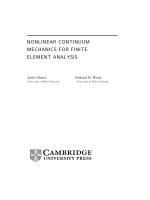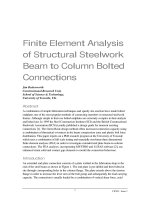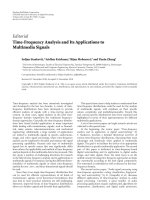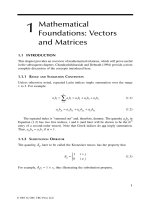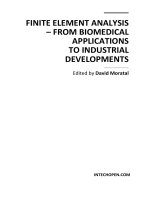FINITE ELEMENT ANALYSIS – FROM BIOMEDICAL APPLICATIONS TO INDUSTRIAL DEVELOPMENTS docx
Bạn đang xem bản rút gọn của tài liệu. Xem và tải ngay bản đầy đủ của tài liệu tại đây (31.52 MB, 508 trang )
FINITE ELEMENT ANALYSIS
– FROM BIOMEDICAL
APPLICATIONS
TO INDUSTRIAL
DEVELOPMENTS
Edited by David Moratal
Finite Element Analysis –
From Biomedical Applications to Industrial Developments
Edited by David Moratal
Published by InTech
Janeza Trdine 9, 51000 Rijeka, Croatia
Copyright © 2012 InTech
All chapters are Open Access distributed under the Creative Commons Attribution 3.0
license, which allows users to download, copy and build upon published articles even for
commercial purposes, as long as the author and publisher are properly credited, which
ensures maximum dissemination and a wider impact of our publications. After this work
has been published by InTech, authors have the right to republish it, in whole or part, in
any publication of which they are the author, and to make other personal use of the
work. Any republication, referencing or personal use of the work must explicitly identify
the original source.
As for readers, this license allows users to download, copy and build upon published
chapters even for commercial purposes, as long as the author and publisher are properly
credited, which ensures maximum dissemination and a wider impact of our publications.
Notice
Statements and opinions expressed in the chapters are these of the individual contributors
and not necessarily those of the editors or publisher. No responsibility is accepted for the
accuracy of information contained in the published chapters. The publisher assumes no
responsibility for any damage or injury to persons or property arising out of the use of any
materials, instructions, methods or ideas contained in the book.
Publishing Process Manager Oliver Kurelic
Technical Editor Teodora Smiljanic
Cover Designer InTech Design Team
First published March, 2012
Printed in Croatia
A free online edition of this book is available at www.intechopen.com
Additional hard copies can be obtained from
Finite Element Analysis – From Biomedical Applications to Industrial Developments,
Edited by David Moratal
p. cm.
ISBN 978-953-51-0474-2
Contents
Preface IX
Part 1 Dentistry, Dental Implantology and Teeth Restoration 1
Chapter 1 Past, Present and Future
of Finite Element Analysis in Dentistry 3
Ching-Chang Ko, Eduardo Passos Rocha and Matt Larson
Chapter 2 Finite Element Analysis in Dentistry –
Improving the Quality of Oral Health Care 25
Carlos José Soares, Antheunis Versluis,
Andréa Dolores Correia Miranda Valdivia,
Aline Arêdes Bicalho, Crisnicaw Veríssimo,
Bruno de Castro Ferreira Barreto and Marina Guimarães Roscoe
Chapter 3 FEA in Dentistry:
A Useful Tool to Investigate the Biomechanical
Behavior of Implant Supported Prosthesis 57
Wirley Gonçalves Assunção, Valentim Adelino Ricardo Barão, Érica
Alves Gomes, Juliana Aparecida Delben and Ricardo Faria Ribeiro
Chapter 4 Critical Aspects for Mechanical
Simulation in Dental Implantology 81
Erika O. Almeida, Amilcar C. Freitas Júnior,
Eduardo P. Rocha, Roberto S. Pessoa, Nikhil Gupta,
Nick Tovar and Paulo G. Coelho
Chapter 5 Evaluation of Stress Distribution in Implant-Supported
Restoration Under Different Simulated Loads 107
Paulo Roberto R. Ventura, Isis Andréa V. P. Poiate,
Edgard Poiate Junior
and Adalberto Bastos de Vasconcellos
Chapter 6 Biomechanical Analysis of Restored Teeth with
Cast Intra-Radicular Retainer with and Without Ferrule 133
Isis Andréa Venturini Pola Poiate,
Edgard Poiate Junior and Rafael Yagϋe Ballester
VI Contents
Part 2 Cardiovascular and Skeletal Systems 165
Chapter 7 Finite Element Analysis
to Study Percutaneous Heart Valves 167
Silvia Schievano, Claudio Capelli, Daria Cosentino,
Giorgia M. Bosi and Andrew M. Taylor
Chapter 8 Finite Element Modeling and Simulation
of Healthy and Degenerated Human Lumbar Spine 193
Márta Kurutz and László Oroszváry
Chapter 9 Simulation by Finite Elements of Bone
Remodelling After Implantation of Femoral Stems 217
Luis Gracia, Elena Ibarz, José Cegoñino,
Antonio Lobo-Escolar, Sergio Gabarre, Sergio Puértolas,
Enrique López, Jesús Mateo, Antonio Herrera
Chapter 10 Tissue Modeling and Analyzing for
Cranium Brain with Finite Element Method 251
Xianfang Yue, Li Wang, Ruonan Wang,
Yunbo Wang and Feng Zhou
Part 3 Materials, Structures,
Manufacturing Industry and Industrial Developments 285
Chapter 11 Identification of Thermal Conductivity of Modern
Materials Using the Finite Element Method and
Nelder-Mead's Optimization Algorithm 287
Maria Nienartowicz and Tomasz Strek
Chapter 12 Contact Stiffness Study:
Modelling and Identification 319
Hui Wang, Yi Zheng and Yiming (Kevin) Rong
Chapter 13 Application of Finite Element Analysis
in Sheet Material Joining 343
Xiaocong He
Chapter 14 Modeling of Residual Stress 369
Kumaran Kadirgama, Rosli Abu Bakar,
Mustafizur Rahman and Bashir Mohamad
Chapter 15 Reduction of Stresses in Cylindrical Pressure
Vessels Using Finite Element Analysis 379
Farhad Nabhani, Temilade Ladokun and Vahid Askari
Chapter 16 Finite Element Analysis of Multi-Stable Structures 391
Fuhong Dai and Hao Li
Contents VII
Chapter 17 Electromagnetic and Thermal Analysis
of Permanent Magnet Synchronous Machines 407
Nicola Bianchi, Massimo Barcaro and Silverio Bolognani
Chapter 18 Semi-Analytical Finite Element Analysis of
the Influence of Axial Loads on Elastic Waveguides 439
Philip W. Loveday, Craig S. Long and Paul D. Wilcox
Chapter 19 Finite Element Analysis of Desktop Machine Tools
for Micromachining Applications 455
M. J. Jackson, L. J. Hyde, G. M. Robinson and W. Ahmed
Chapter 20 Investigation of Broken Rotor Bar Faults
in Three-Phase Squirrel-Cage Induction Motors 477
Ying Xie
Preface
Finite Element Analysis originated from the need for solving complex elasticity and
structural analysis problems in civil and aeronautical engineering, and its
development can be traced back to 1941. It consists of a numerical technique for
finding approximate solutions to partial differential equations as well as integral
equations, permitting the numerical analysis of complex structures based on their
material properties.
This book represents a selection of chapters exhibiting various investigation directions
in the field of Finite Element Analysis. It is composed of 20 different chapters, and they
have been grouped in three main sections: “Dentistry, Dental Implantology and Teeth
Restoration” (6 chapters), “Cardiovascular and Skeletal Systems” (4 chapters), and
“Materials, Structures, Manufacturing Industry and Industrial Developments” (10 chapters).
The chapters have been written individually by different authors, and each chapter
can be read independently from others. This approach allows the selection of a chapter
the reader is most interested in, without being forced to read the book in its entirety. It
offers a colourful mix of applications of Finite Element Modelling ranging from
orthodontics or dental implants, to percutaneous heart valve devices, intervertebral
discs, thermal conductivity, elastic waveguides, and several other exciting topics.
This book serves as a good starting point for anyone interested in the application of
Finite Elements. It has been written at a level suitable for use in a graduate course on
applications of finite element modelling and analysis (mechanical, civil and biomedical
engineering studies, for instance), without excluding its use by researchers or
professional engineers interested in the field.
I would like to remark that this book complements another book from this same
publisher (and this same editor) entitled “Finite Element Analysis”, which provides
some other exciting subjects that the reader of this book might also consider
interesting to read.
Finally, I would like to acknowledge the authors for their contribution to the book and
express my sincere gratitude to all of them for their outstanding chapters.
X Preface
I also wish to acknowledge the InTech editorial staff, in particular Oliver Kurelic, for
indispensable technical assistance in the book preparation and publishing.
David Moratal
Polytechnic University of Valencia, Valencia,
Spain
Part 1
Dentistry, Dental Implantology
and Teeth Restoration
1
Past, Present and Future of Finite
Element Analysis in Dentistry
Ching-Chang Ko
1,2,*
, Eduardo Passos Rocha
1,3
and Matt Larson
1
1
Department of Orthodontics,
University of North Carolina School of Dentistry,
2
Department of Material Sciences and Engineering,
North Carolina State University Engineering School, Raleigh,
3
Faculty of Dentistry of Araçatuba, UNESP,
Department of Dental Materials and Prosthodontics, Araçatuba, Saõ Pauló,
1,2
USA
3
Brazil
1. Introduction
Biomechanics is fundamental to any dental practice, including dental restorations,
movement of misaligned teeth, implant design, dental trauma, surgical removal of impacted
teeth, and craniofacial growth modification. Following functional load, stresses and strains
are created inside the biological structures. Stress at any point in the construction is critical
and governs failure of the prostheses, remodeling of bone, and type of tooth movement.
However, in vivo methods that directly measure internal stresses without altering the tissues
do not currently exist. The advances in computer modeling techniques provide another
option to realistically estimate stress distribution. Finite element analysis (FEA), a computer
simulation technique, was introduced in the 1950s using the mathematical matrix analysis of
structures to continuum bodies (Zienkiewicz and Kelly 1982). Over the past 30 years, FEA
has become widely used to predict the biomechanical performance of various medical
devices and biological tissues due to the ease of assessing irregular-shaped objects
composed of several different materials with mixed boundary conditions. Unlike other
methods (e.g., strain gauge) which are limited to points on the surface, the finite element
method (FEM) can quantify stresses and displacement throughout the anatomy of a three
dimensional structure.
The FEM is a numerical approximation to solve partial differential equations (PDE) and
integral equations (Hughes 1987, Segerlind 1984) that are formulated to describe physics of
complex structures (like teeth and jaw joints). Weak formulations (virtual work principle)
(Lanczos 1962) have been implemented in FEM to solve the PDE to provide stress-strain
solutions at any location in the geometry. Visual display of solutions in graphic format adds
attractive features to the method. In the first 30 years (1960-1990), the development of FEM
*
Corresponding Author
Finite Element Analysis – From Biomedical Applications to Industrial Developments
4
programs focused on stability of the solution including minimization of numerical errors
and improvement of computational speed. During the past 20 years, 3D technologies and
non-linear solutions have evolved. These developments have directly affected automobile
and aerospace evolutions, and gradually impacted bio-medicine. Built upon engineering
achievement, dentistry shall take advantage of FEA approaches with emphasis on
mechanotherapy. The following text will review history of dental FEA and validation of
models, and show two examples.
2. History of dental FEA
2.1 1970-1990: Enlightenment stage -2D modeling
Since Farah’s early work in restorative dentistry in 1973, the popularity of FEA has grown.
Early dental models were two dimensional (2D) and often limited by the high number of
calculations necessary to provide useful analysis (Farah and Craig 1975, Peters et al., 1983,
Reinhardt et al., 1983, Thresher and Saito 1973). During 1980-1990, the plane-stress and
plane-strain assumptions were typically used to construct 2D tooth models that did not
contain the hoop structures of dentin because typically either pulp or restorative material
occupied the central axis of the tooth (Anusavice et al., 1980). Additional constraints (e.g.,
side plate and axisymmetric) were occasionally used to patch these physical deficiencies
(hoop structures) to prevent the separation of dentin associated with the 2D models (Ko,
1989). As such a reasonable biomechanical prediction was derived to aid designs of the
endodontic post (Ko et al., 1992). Axisymmetric models were also used to estimate stress
distribution of the dental implants with various thread designs (Rieger et al., 1990).
Validation of the FE models was important in this era because assumptions and constraints
were added to overcome geometric discontinuity in the models, leading to potential
mathematical errors.
2.2 “1990-2000” beginnings stage of 3D modeling
As advancements have been made in imaging technologies, 3D FEA was introduced to
dentistry. Computer tomography (CT) data provide stacks of sectional geometries of human
jaws that could be digitized and reconstructed into the 3D models. Manual and semi-
automatic meshing was gradually evolved during this time. The 3D jaw models and tooth
models with coarse meshes were analyzed to study chewing forces (Korioth 1992, Korioth
and Versluis 1997, Jones et al., 2001) and designs of restorations (Lin et al., 2001). In general,
the element size was relatively large due to the immature meshing techniques at that time,
which made models time consuming to build. Validation was required to check accuracy of
the stress-strain estimates associated with the coarse-meshed models. In addition to the
detail of 3D reconstruction, specific solvers (e.g., poroelasticity, homogenization theory,
dynamic response) were adapted from the engineering field to study dental problems that
involved heterogeneous microstructures and time-dependent properties of tissues.
Interfacial micromechanics and bone adaptation around implants were found to be highly
non-uniform, which may dictate osseointegration patterns of dental implants (Hollister et
al., 1993; Ko 1994). The Monte Carlo model (probability prediction), with incorporation of
the finite element method for handling irregular tooth surface, was developed by Wang and
Past, Present and Future of Finite Element Analysis in Dentistry
5
Ko et al (1999) to stimulate optical scattering of the incipient caries (e.g., white spot lesion).
The simulated image of the lesion surface was consistent with the true image captured in
clinic (Figure 1). Linear fit of the image brightness between the FE and clinical images was
85% matched, indicating the feasibility of using numerical model to interpret clinical white
spot lesions. The similar probability method was recently used to predict healing bone
adaptation in tibia (Byrne et al., 2011). Recognition of the importance of 3D models and
specific solutions were the major contributions in this era.
(A) (B) (C)
Fig. 1. A. Finite element mesh of in vivo carious tooth used for Monte Carlo simulation;
B. Image rendered from Monte Carlo 3D simulation, C. True image of carious tooth
obtained from a patient’s premolar using an intra-oral camera.
2.3 “2000-2010” age of proliferation, 3D with CAD
As advancements have been made in computer and software capability, more complex 3D
structures (e.g., occlusal surfaces, pulp, dentin, enamel) have been simulated in greater
detail. Many recent FE studies have demonstrated accurate 3D anatomic structures of a
sectioned jaw-teeth complex using μCT images. Increased mathematical functions in 3D
computer-aid-design (CAD) have allowed accurate rendition of dental anatomy and
prosthetic components such as implant configuration and veneer crowns (Figure 2). Fine
meshing and high CPU computing power appeared to allow calculation of mechanical fields
(e.g., stress, strain, energy) accounting for anatomic details and hierarchy interfaces between
different tissues (e.g., dentin, PDL, enamel) that were offered by the CAD program. It was
also recognized that inclusion of complete dentition is necessary to accurately predict stress-
strain fields for functional treatment and jaw function (Field et al. 2009). Simplified models
containing only a single tooth overlooked the effect of tooth-tooth contacts that is important
in specified biomechanical problems such as orthodontic tooth movement and traumatic
tooth injury. CAD software such as SolidWorks© (Waltham, MA, USA), Pro Engineering©
(Needham, MA), and Geomagic (Triangle Park, NC, USA) have been adapted to construct
dentofacial compartments and prostheses. These CAD programs output solid models that
are then converted to FE programs (e.g., Abaqus, Ansys, Marc, Mimics) for meshing and
solving. The automeshing capability of FE programs significantly improved during this era.
Finite Element Analysis – From Biomedical Applications to Industrial Developments
6
Fig. 2. Fine finite element mesh generated for ceramics veneer simulation.
3. Current development of 3D dental solid models using CAD programs
Currently, solid models have been created from datasets of computer tomography (CT)
images, microCT images, or magnetic resonance images (MRI). To create a solid model from
an imaging database, objects first need to be segregated by identifying interfaces. This is
performed through the creation of non-manifold assemblies either through sequential 2D
sliced or through segmentation of 3D objects. For this type of model reconstruction, the
interfaces between different bodies are precisely specified, ensuring the existence of
common nodes between different objects of the contact area. This provides a realistic
simulation of load distribution within the object. For complex interactions, such as bone-
implant interfaces or modeling the periodontal ligament (PDL), creation of these coincident
nodes is essential.
When direct engineering (forward engineering) cannot be applied, reverse engineering is
useful for converting stereolithographic (STL) objects into CAD objects (.iges). Despite
minor loss of detail, this was the only option for creation of 3D organic CAD objects until the
development of 3D segmentation tools and remains a common method even today. The
creation of STL layer-by-layer objects requires segmentation tools, such as ITK-SNAP
(Yushkevich et al., 2006) to segment structures in 3D medical images. SNAP provides semi-
automatic segmentation using active contour methods, as well as manual delineation and
image navigation.
Following segmentation, additional steps are required to prepare a model to be imported
into CAD programs. FEA requires closed solid bodies – in other words, each part of the
model should be able to hold water. Typical CT segmentations yield polygon surfaces with
irregularities and possible holes. A program capable of manipulating these polygons and
creating solid CAD bodies is required, such as Geomagic (Triangle Park, NC, USA).
Past, Present and Future of Finite Element Analysis in Dentistry
7
Although segmentations may initially appear very accurate (Figure 3A), there are often
many small irregularities that must be addressed (Figure 3B). Obviously, organic objects
will have natural irregularities that may be important to model, but defects from the
scanning and segmentation process must be removed. Automated processes in Geomagic
such as mesh doctor can identify problematic areas (Figure 3B) and fix many minor
problems. For larger defects, defeaturing may be required. Once the gaps in the surface have
been filled, some amount of smoothing is typically beneficial. Excess surface detail that will
not affect results only increases the file size, meshing times, mesh density, and solution
times. To improve surfacing, a surface mesh on the order of 200,000 polygons is
recommended. Geomagic has a tool (“optimize for surfacing”) that redistributes the
polygons nodes on the surface to create a more ideal distribution for surfacing (Figure 3C).
Following these optimization steps, it is important to compare the final surface to the initial
surface to verify that no significant changes were made.
Fig. 3. Although initial geometry following segmentation can appear smooth (A), many
small defects are present that Geomagic will highlight in red using "mesh doctor" as
potentially problematic (B). Following closing gaps, smoothing, minor defeaturing, and
optimization for surfacing, the polygon mesh is greatly improved (C).
With the optimized surfaces prepared using the previous steps, closed solid bodies can be
created. Although the actual final bodies with the interior and exterior surfaces can be
created at this stage, we have observed that closing each surface independently and using
Booleans in the CAD program typically improves results. For example, this forces the
interior surface of the enamel to be the identical surface as the exterior of the dentin. If the
Boolean operations are done prior to surfacing, minor differences in creating NURB surfaces
Finite Element Analysis – From Biomedical Applications to Industrial Developments
8
may affect the connectivity of the objects. Some research labs (Bright and Rayfield 2011) will
simply transfer the polygon surfaces over to a FEA program for analysis without using a
CAD program. This can be very effective for relatively simple models, but when multiple
solid bodies are included and various mesh densities are required this process becomes
cumbersome.
To use a CAD program with organic structures, the surface cannot be a polygon mesh, but
rather needs to have a mathematical approximation of the surface. This is typically done
with NURB surfaces, so the solid can be saved as an .iges or .step file. This process involves
multiple steps – laying out patches, creating grids within these patches, optimizing the
surface detail, and finally creating the NURB surface (Figure 4). Surfacing must be done
carefully as incorrectly laying out the patches on the surface or not allowing sufficient detail
may severely distort the surface. In the end, the surfaced body should not have problematic
geometry, such as sliver faces, small faces, or small edges.
Fig. 4. Process of NURB surface generation using Geomagic. (A) Contour lines are defined
that follow the natural geometry - in this case, line angles were used. (B) Patches are
constructed and shuffled to create a clean grid pattern. (C) Grids are created within each
patch. (D) NURB surfaces are created by placing control points along the created grids.
CAD programs allow the incorporation of high definition materials or parts from geometry
files (e.g. .iges, .step), such as dentures, prosthesis, orthodontics appliances, dental
restorative materials, surgical plates and dental implants. They even allow partial
modification of the solid model obtained by CT or μCT to more closely reproduce accurate
organic geometry. Organic modeling (biomodeling) extensively uses splines and curves to
model the complex geometry. FE software or other platforms with limited CAD tools
typically do not provide the full range of features required to manipulate these complicated
organic models. Therefore, the use of a genuine CAD program is typically preferred for
detailed characterization of the material and its contact correlation with surrounding
structures. This is especially true for models that demand strong modification of parts or
incorporation of multiple different bodies.
When strong modification is required, the basic parts of the model such as bone, skin or
basic structures can be obtained in .stl format. They are then converted to a CAD file
allowing modification and/or incorporation of new parts before the FE analysis. It is also
possible to use the CT or microCT dataset to directly create a solid in the CAD program.
Past, Present and Future of Finite Element Analysis in Dentistry
9
A.
B.
C.
Fig. 5. The solid model of a maxillary central incisor was created through the following
steps. (A) Multiple sketches were created in various slices of the microCT data. The sketch
defined the contour of the root. (B) Sequential contours were used to reconstruct outer
surface of dentin and other parts (e.g., enamel and pulp - not shown). (C) All parts (enamel,
dentin and pulp) were combined to form the solid model of the central incisor. All
procedures were performed using SolidWorks software.
Finite Element Analysis – From Biomedical Applications to Industrial Developments
10
Initially, this procedure might be time-consuming. However, it is useful for quickly and
efficiently making changes in parts, resizing multiple parts that are already combined, and
incorporating new parts. This also allows for serial reproduction of unaltered parts of the
model, such as loading areas and unaltered support structures, keeping their dimensions
and Cartesian coordinates.
This procedure involves the partial or full use of the dataset, serially organized, to create
different parts. (Figures 5 A & B) In models with multiple parts, additional tools such as
lofts, sweeps, surfaces, splines, reference planes, and lines can be used to modify existing
solids or create new solids (Figures 5C). Different parts may be combined through Boolean
operations to generate a larger part, to create spaces or voids, or to modify parts. The parts
can be also copied, moved, or mirrored in order to reproduce different scenarios without
creating an entirely new model.
4. Finite element analysis of the current dental models
4.1 Meshing
For descritization of the solid model, most FE software has automated mesh generating
features that produce rather dense meshes. However, it is important to enhance the
controller that configures the elements including types, dimensions, and relations to
better fit the analysis to a particular case and its applications. Most of current FE software
is capable of assessing the quality of the mesh according to element aspect ratio and the
adaptive method. The ability of the adaptive method to automatically evaluate and
modify the contact area between two objects overlapping the same region and to refine
the mesh locally in areas of greater importance and complexity has profoundly improved
the accuracy of the solution. Although automated mesh generation has greatly improved,
note that it still requires careful oversight based on the specific analysis being performed.
For example, when examining stresses produced in the periodontal ligament with
orthodontic appliances, the mesh will be greatly refined in the small geometry of the
orthodontic bracket, but may be too coarse in the periodontal ligament – the area of
interest.
The validation that was concerned with meshing errors and morphological inaccuracy
during 1970 ─ 2000 is no longer a major concern as the CAD and meshing technology
evolves. However, numerical convergence (Huang et al., 2007) is still required, which is
frequently neglected in dental simulations (Tanne et al., 1987; Jones et al., 2001; Liang et
al., 2009; Kim et al., 2010). Some biologists ignore all results from FEA, requesting an
unreasonable level of validation for each model, but overlooking the valuable
contributions of engineering principles. A rational request should recognize evolution of
the advanced technologies but focus on numerical convergence. The numerical
convergence is governed by two factors, continuity and approximation methods, and can
be classified to strong convergence ||X
n
|| ||X|| as n ∞ and weak convergence
∫(X
n
) ∫(X) as n ∞ where X
n
represents physical valuables such as displacement,
temperature, and velocity. X represents the exact solution and ∫ indicates the potential
energy. It is recommended that all dental FE models should test meshing convergence
prior to analyses.
Past, Present and Future of Finite Element Analysis in Dentistry
11
4.2 Validity of the models
The validity of the dental FEA has been a concern for decades. Two review articles (Korioth
and Versluis, 1997; Geng et al., 2001) in dentistry provided thorough discussions about
effects of geometry, element type and size, material properties, and boundary conditions on
the accuracy of solutions. In general these discussions echoed an earlier review by Huiskes
and Cao (1983). The severity of these effects has decreased as the technologies and
knowledge evolved in the field. In the present CAD-FEA era, the consideration of FEA
accuracy in relation to loading, boundary (constraint) conditions, and validity of material
properties are described as follows:
4.2.1 Loading
The static loading such as bite forces is usually applied as point forces to study prosthetic
designs and dental restorations. The bite force, however, presents huge variations (both
magnitude and direction) based on previous experimental measures (Proffit et al., 1983;
Proffit and Field 1983). Fortunately, FEA allows for easy changes in force magnitudes and
directions to approximate experimental data, which can serve as a reasonable parametric
study to assess different loading effects. On the other hand, loading exerted by devices such
as orthodontic wires is unknown or never measured experimentally, and should be
simulated with caution (see the section 5.2)
4.2.2 Boundary Condition (BC)
The boundary condition is a constraint applied to the model, from which potential energy
and solutions are derived. False solutions can be associated at the areas next to the
constraints. As a result, most dental models set constraints far away from the areas of
interest. Based on the Saint-Venant’s principle, the effects of constraints at sufficiently
large distances become negligible. However, some modeling applies specific constraints
to study particular physical phenomenon. For example, the homogenization theory was
derived to resolve microstructural effects in composite by applying periodic constraints
(Ko et al., 1996). It was reported that using homogenization theory to estimate bone-
implant interfacial stresses by accounting for microstructural effects might introduce up
to 20% error (Ko 1994).
4.2.3 Material properties
Mechanical properties of biological tissues remain a major concern for the FE approach
because of the viscoelastic nature of biological tissues that prevents full characterization of
its time-dependent behaviors. Little technology is available to measure oral tissue
properties. Most FE studies in dentistry use the linear elastic assumption. Data based on
density from CT images can be used to assign heterogeneous properties. Few researches
attempting to predict non-linear behaviors using bilinear elastic constants aroused risks for
a biased result (Cattaneo et al., 2009). Laboratory tests excluding tissues (e.g., PDL) were
also found to result in less accurate data than computer predictions (Chi et al., 2011).
Caution must be used when laboratory data is applied to validate the model. To our
knowledge, the most valuable data for validation resides on clinical assessments such as
measuring tooth movement (Yoshida et al., 1998; Brosh et al., 2002).
Finite Element Analysis – From Biomedical Applications to Industrial Developments
12
4.3 Solution/principle
The weak form of the equilibrium equation for classic mechanics is given below:
() ()
ijkl ij kl i i
vud d
ctv
, where
represents the total domain of the object, and
i
t
represents tractions. ε is obtained by applying the small strain-displacement relationship
1
() ( )
2
j
i
ij
j
i
u
u
u
xx
. Stresses will be obtained by the constitutive law
ijkl
i
j
kl
E
. Using
the variational formulation and mesh descritization, this equilibrium equation can be
assembled by the individual element
t
e
BDBde
. plus the boundary integral where B
is the shape function and D is element stiffness matrix. The element stiffness matrix
represents material property of either a linear or non-linear function. As mentioned above,
mechanical properties of oral tissues are poorly characterized. The most controversial oral
tissue is the PDL due to its importance in supporting teeth and regulating alveolar bone
remodeling. To date, studies conducted to characterize non-linear behaviors of the PDL are
not yet conclusive. One approximation of PDL properties assumes zero stiffness under low
compression resulting in very low stress under compression (Cattaneo et al., 2009).
Interpretation of such non-linear models must be approached with cautious. Consequently,
linear elastic constants are frequently used for dental simulations to investigate initial
responses under static loading.
In addition to the commonly used point forces, the tractions (t
i
) in dental simulations should
consider preconditions (e.g., residual stress, polymerization shrinkage and unloading of
orthodontic archwire). Previously, investigation of composite shrinkage yielded valuable
contributions to restorative dentistry (Magne et al., 1999). In the following section, we will
demonstrate two applications using submodels from a full dentition CAD model: one with
static point loading and the other with deactivated orthodontic archwire bending.
5. Examples of dental FEA
As described in Section 3, a master CAD model with full dentition was developed. The
model separates detailed anatomic structures such as PDL, pulp, dentin, enamel, lamina
dura, cortical bone, and trabecular bone. This state-of-the-art model contains high order
NURB surfaces that allow for fine meshing, with excellent connectivity so the model can be
conformally meshed with concurrent nodes at all interfaces. Many submodels can be
isolated from this master model to study specified biomechanical questions. Two examples
presented here are the first series of applications: orthodontic miniscrews and orthodontic
archwires for tooth movement.
5.1 Orthodontic miniscrews
5.1.1 Introduction
The placement of miniscrews has become common in orthodontic treatment to enhance
tooth movement and to prevent unwanted anchorage loss. Unfortunately, the FE
biomechanical miniscrew models reported to date have been oversimplified or show
Past, Present and Future of Finite Element Analysis in Dentistry
13
incomplete reflections of normal human anatomy. The purpose of this study was to
construct a more anatomically accurate FE model to evaluate miniscrew biomechanics.
Variations of miniscrew insertion angulations and implant materials were analyzed.
5.1.2 Methods
A posterior segment was sectioned from the full maxillary model. Borders of the model
were established as follows: the mesial boundary was at the interproximal region between
the maxillary right canine and first premolar; the distal boundary used the distal aspect of
the maxillary tuberosity; the inferior boundary was the coronal anatomy of all teeth ; and
the superior boundary was all maxillary structures (including sinus and zygoma) up to
15mm superior to tooth apices (Figure 6A).
An orthodontic miniscrew (TOMAS®, 8mm long, 1.6mm diameter) was created using
Solidworks CAD software. The miniscrew outline was created using the Solidworks sketch
function and revolved into three dimensions. The helical sweep function was used to create a
continuous, spiral thread. Subtraction cuts were used to create the appropriate head
configuration after hexagon ring placement. The miniscrew was inserted into the maxillary
model from the buccal surface between the second premolar and first molar using Solidworks.
The miniscrew was inserted sequentially at angles of 90°, 60° and 45° vertically relative to the
surface of the cortical bone (Figure 6B), and was placed so that the miniscrew neck/thread
interface was coincident with the external contour of the cortical bone. For each angulation, the
point of intersection between the cortical bone surface and the central axis of the miniscrew
was maintained constant to ensure consistency between models. Boolean operations were
performed and a completed model assembly was created at each angulation.
(A) (B) (C)
Fig. 6. The FE model of the orthodontic miniscrew used in the present study. (A) The solid
model of four maxillary teeth plus the miniscrew was created using SolidWorks. (B) Close
look of the miniscrew inserted to the bone. (C) FE mesh was generated by Ansys Workbench
10.0. F indicates the force (1.47 N = 150gm) applied to the miniscrew.
The IGES format file of each finished 3D model was exported to ANSYS 10.0 Workbench
(Swanson Analysis Inc., Huston, PA, USA), and FE models with 10-node tetrahedral h-
elements were generated for each assembly. The final FE mesh generated for each model
contained approximately 91,500 elements, which was sufficient to obtain solution
convergence. Following FE mesh generation, the model was fixed at the palatal, mesial, and
